After three days, the reservation line reports all of the spots on the Percorso del Principe tours have been filled. Tuscan Traveler suggests that such popularity calls for more tours on more days…
The Vasari Corridor, also known as the Percorso del Principe (Path of the Prince), is open to the general public until July 2010 on a limited schedule. A special part of the city’s historical heritage that has been under the control of few select guides and museum officials (often costing the visitor more than 100 euro for a short tour) has been declared open to all by the new mayor of Florence.
A Unique Opportunity
Visitors to Florence know that to miss the Uffizi, the Ponte Vecchio with its famous gold merchants, and the gaudy splendors of the Pitti Palace is to miss Florence’s best-known sites.
What many tourists do not know is that along this same sightseeing path they also have a unique opportunity to walk in the footsteps of Renaissance nobility. Here they can view a vast collection of paintings usually reserved for the pleasure of a select few. It is called the Vasari Corridor.
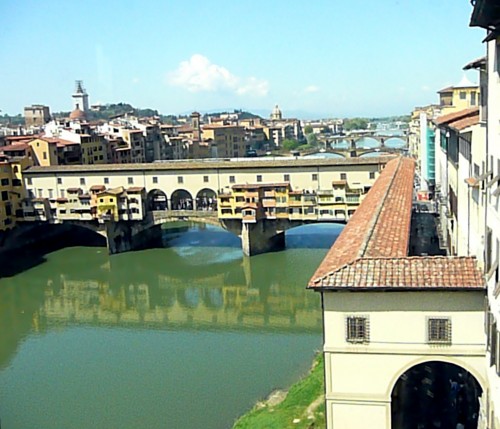
The Vasari Corridor is an aerial passageway that connects the Palazzo Vecchio on one side of the River Arno to the Palazzo Pitti on the other. It passes over roofs and bridge of the Ponte Vecchio, and through galleries, mansions and churches. At over 500 meters (.33 miles), it is the longest single passageway of paintings and portraits in the world.
In 2010, the Italian Cultural Ministry and the City of Florence, urged on by Mayor Renzi, created a special “Prince’s Itinerary”, Il Percorso del Principe, as a guided tour to introduce the public to the Vasari Corridor. Still relatively unknown, it is one of the most exceptional and, until recently, hidden treasures of Renaissance architecture and art.
Tour participants not only see a fabulous art collection, but also are shown a hidden route with unique views and unexpected secret glimpses of the classic Florentine cityscape while walking above the heads of tourists swarming the streets below.
History of the Corridor
In the 1540’s, Cosimo I, an enlightened despot who ruled Florence and all of Tuscany, lived with his Spanish wife Eleonora di Toledo and their children above the “shop” in the Palazzo Vecchio, the Florence City Hall. Eleonora was in charge of the family finances and disliked living in the Palazzo Vecchio. In 1549, she found a house she did want, and so purchased the Palazzo Pitti from the debt-encumbered Pitti family, rivals of the Medici clan. She had the palace remodeled and enlarged. The façade grew to over 670 feet in length, becoming the grandest of the Renaissance palaces and the seat of the Medici dynasty for the next 200 years.
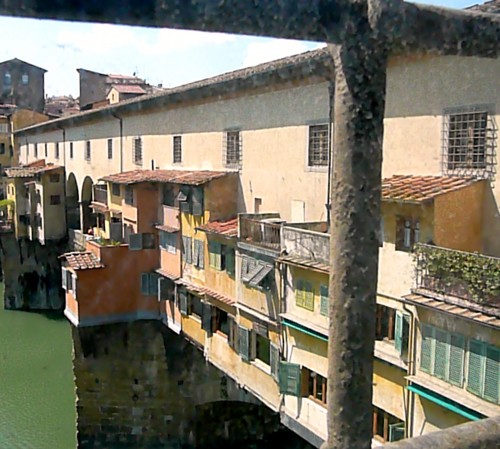
Eleonora moved her family out of the city hall, thus forcing Cosimo to commute almost half a mile through the city streets to the government offices. A man with many enemies and one who did not mix well with the general public, Cosimo had to travel with a contingent of bodyguards. Each day they had to traverse a narrow chaotic bridge, the Ponte Vecchio, which in the 1500’s was lined with malodorous tanneries and butcher shops.
Using the occasion of his son Francesco’s 1565 wedding to Joanna of Austria as an excuse, Cosimo commissioned his architect Giorgio Vasari to design an above-ground walkway from his home to the offices. Vasari, a true man of the Renaissance – architect, painter, author and art historian – took only six months to design and direct the building of the Corridor. Cosimo did not own all of the property between the Palazzo Vecchio and the Palazzo Pitti. Vasari thus had to get permission to build the Corridor through other people’s towers, mansions and businesses. When the Mannelli family refused permission for the corridor to pass through their tower, situated at the south end of the Ponte Vecchio, Vasari designed the passageway to be built around, but attached to, il torre dei Mannelli.
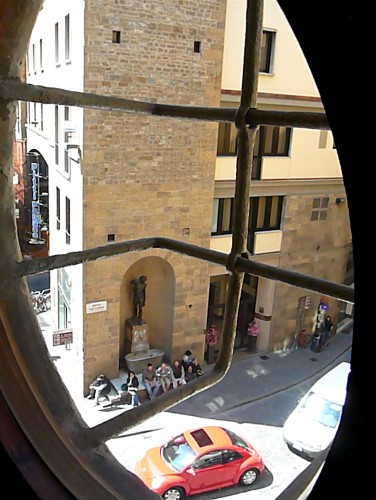
Cosimo claimed that the architectural wonder was for the amazement of the wedding guests and to remind the citizens of Florence of his power and authority, but he also gained an escape route from either home or office and a way to spy on the Florentines from above many of the busiest thoroughfares. The Corridor was also eventually used as a nursery for many generations of Medici children; and the elderly, infirm and lazy could be wheeled through the corridor in basket chairs. Apparently, however, the stench of the Ponte Vecchio remained a problem because in 1594, Cosimo’s son Fernando decreed that the butchers and tanners would be ousted and replaced by gold- and silversmiths.
The Tour
The Percorso del Principe Tour begins in the courtyard of the Palazzo Vecchio. It always numbers less than 20 participants and lasts about two hours. The tour group meets in the courtyard of the Palazzo Vecchio, proceeds to the Hall of the Five Hundred, Il Salone dei Cinquecento, where an Italian-speaking guide presents a short history lesson regarding the Medici, the Palazzo Vecchio and the Vasari Corridor.
The itinerary includes parts of the Palazzo Vecchio Museum. Each group is escorted through a number of governmental chambers to Eleonora’s Green Room, La Camera Verde, in the former Medici family apartments on the second floor. From there the group crosses a short sky bridge, part of the original Corridor, over Via della Ninna, and enters the east wing of the Uffizi Gallery. Tour participants have a chance to examine only the east hallway of the Uffizi – the ticket does not allow for free re-entry into the Gallery that holds the largest collection of Italian medieval and Renaissance art in the world.
The main branch of the Vasari Corridor is entered via a doorway located at the beginning of the west corridor of the Uffizi. The passage drops down a long stairway flanked by paintings from the Medici collection and then traverses the top of the arcade on the north bank of the Arno, turns right over the shops on the Ponte Vecchio, and continues on through to the Boboli Gardens of the Palazzo Pitti. Visitors exit into the garden and can remain there for the rest of the day.
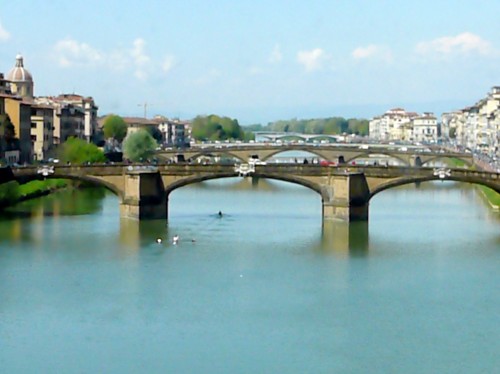
Small windows all along the Corridor provide excellent views of the river and the city. The best view is in the center of the Ponte Vecchio through two large sets of windows that look west down the Arno. These windows were not part on the original design, but were installed at the direction of Mussolini during World War II because Hitler and Mussolini wanted to look at the view while they held private meetings in the Corridor.
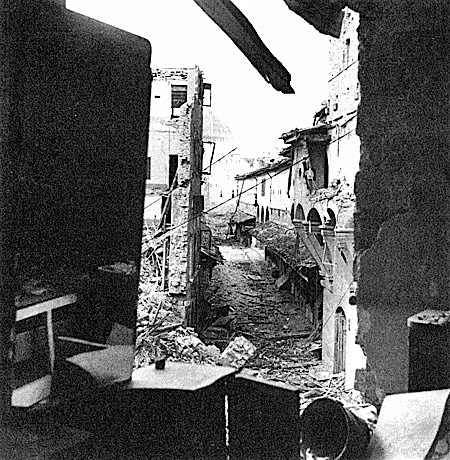
By some reports, Hitler’s fondness for the Corridor and the Ponte Vecchio spared both when the retreating Germans blew up all of the other bridges crossing the Arno as the Allies advanced on Florence in August 1944. The Corridor, however, was damaged by the dynamite set at the ends of the Ponte Vecchio to block passage over the Old Bridge.
Near the south bank of the river, the Corridor passes through the interior of the church of Santa Felicita. A Corridor window looks over the gray and white pietra serena interior of the chapel, and a door enters a high rear balcony, similar to an exclusive box at the opera, where the Medici family attended services in comfort and privacy.
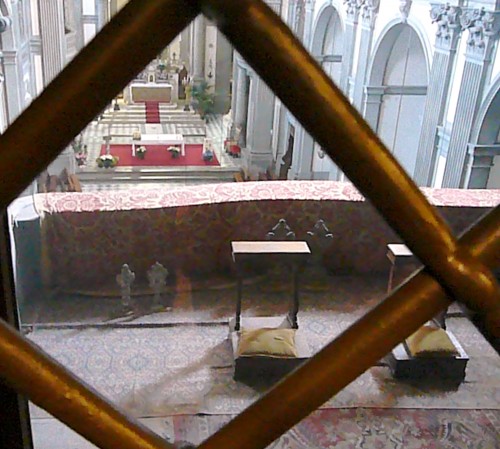
Past the church, the tour ends in the Boboli Gardens, next to the elaborate grotto designed by Bountalenti in the 1580s. At the end of the tour, participants may remain in the massive Giordino di Boboli to explore its many acres of walkways and gardens. Laid out for Eleonora di Toledo by Niccolo Tribolo in 1550, it is one of the finest examples of an Italianate landscape design.
The Collection of Paintings and Portraits
The paintings in the Corridor are arranged in three major groups.
The first collection, which starts at the doorway from the Uffizi Gallery and ends as the Corridor turns on to the Ponte Vecchio, is a group of 17th and 18th century paintings by Italian and other European artists. Acquired by the Medici clan, Cardinal Leopoldo de’Medici at his death left a collection of 730 paintings, 318 sculptures, 1,245 drawings, 589 small portraits, and thousands of medals and other objet d’arte. A small portion of his collection is displayed in the Corridor, including a number of paintings from the school of Caravaggio. Notable among the first collection are pieces by Guido Reni, Gerrit van Honthorst, Empoli, and Guercino.
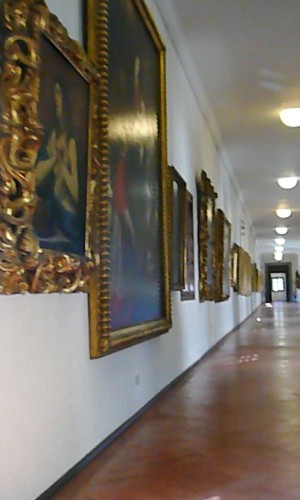
Next, as the Corridor starts across the Ponte Vecchio, there is the world’s largest collection of self-portraits, arranged chronologically, of Italian and other European artists. Cardinal Leopoldo, inspired to start the series, collected over 80 portraits in the 17th century. The set was then augmented by earlier pieces obtained by other members of the Medici family. Still more were added throughout the 18th, 19th, and 20th centuries by artist donation and acquisition by the Uffizi.
Only a portion of the total collection of self-portraits is hung on the Corridor walls at any one time. Those now on display include Giorgio Vasari, Titian, Correggio, Rubens, Rembrandt, Van Dyck, Velasquez, Sir Joshua Reynolds, Antonio Canova, Delacroix, John Singer Sargent, and Carlo Levi. The last displayed, but not the last to reach the Gallery, is a self-portrait donated by Marc Chagall in 1976. A fake Leonardo da Vinci is also displayed – it was part of the Medici collection, but was found by x-ray to be painted over a 17th century Magdalene.
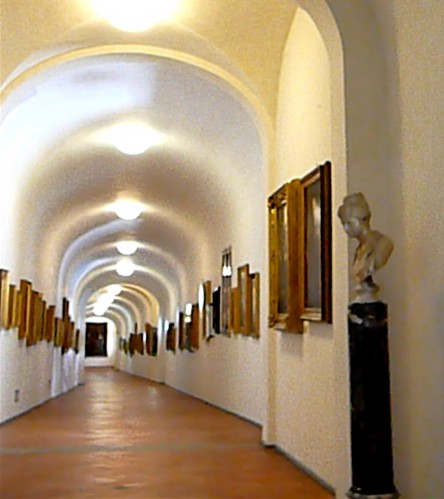
The last group of paintings, displayed in the Corridor where it turns toward the Boboli Gardens, is a collection of Medici and Hapsburg/Lorraine family portraits, many of them of the children. These give valuable insight into the attire and mannerisms of wealthy seventeenth and eighteenth century nobility.
Uncertain Future
Few tourists get to see the inside of the Vasari Corridor. The facility is frequently closed for months at a time, and the unique construction and length of the Corridor requires that tours must be undertaken in small groups guided by Uffizi personnel. There are ongoing discussions about whether the collection in the Corridor should be taken down and tours discontinued due to security and preservation concerns. Now there are rumors of a possible years-long restoration project planned for the corridor.
Details for the 2010 Tours
In 2010 until July 7, tours are available four times on Wednesdays (9:30, 11:30, 2, & 4), two times in the morning on Thurday (9:30 & 11:30) and two times in the afternoon on Fridays (2 & 4).
Tickets to the Percorso del Principe cost 19 euro and allow you to stay in the Boboli Garden at the end of the tour.
Tours are given only in Italian, but the viewing of the Palazzo Vecchio, Uffizi hallways and the Vasari Corridor is so interesting it’s worth the wait as explanations are made to Italian-speaking visitors.
Reservations should be made well in advance through the Florence museum web site www.polomuseale.firenze.it. (The title of the tour is Percorso del Principe and the person taking your reservation will likely not understand if you say “Vasari Corridor”.)
If you are in Florence, tickets can be bought without reservation (if available) at the ticket office on the back of Orasanmichele on Via Calzaiouli or the ticket office at the Pitti Palace. If you make a reservation in advance, you redeem it and purchase your tickets at Door # 2 at the Uffizi Gallery.
The tour group is requested to meet 15 minutes before the tour time at the “Percorso del Principe” sign in the courtyard of the Palazzo Vecchio
